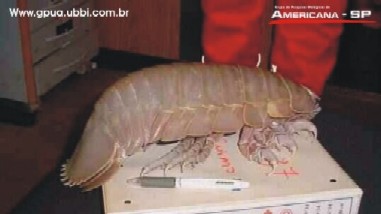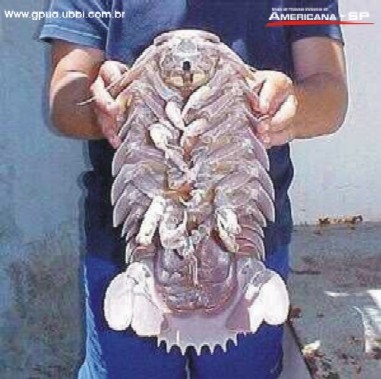Strange Brazilian Creature
Posted by: Loren Coleman on August 27th, 2006
Click on image for full-size version
Click on image for full-size version
Scott Corrales has sent to Cryptomundo the photographs you see here, labeled "Strange Brazilian Creature," with this following message:
These images were just forwarded to me from Spain regarding (and I quote): "a strange creature found by the Servicio de Aguas (Water Authority) of the town of Sorcaba, Brasil. It was taken to a biologist at the zoo (no name given) was was stunned and believed it to be a mutation of a smaller creature."
What Scott is being shown is not cryptozoological, not a mutation of a smaller creature, but represent images of the giant isopods, which are usually found in deep sea explorations.
The giant isopods are crustaceans in the genus Brahynomus. They were first described to science in 1879, and are related to pill bugs and wood lice. They are unusual but otherwise commonly known within marine biology.
Update – The above material is someone attempting to pull off a hoax or joke.
From: Clanders99
Sent: Sun 8/27/2006 5:58 PM
Subject: Strange Brazilian Creature
I enjoy your web site. I just thought I’d drop a line on the "Strange Brazilian Creature." It was identified in Brazil as a hoax some time ago.
(Incidentally, the city is spelled Sorocaba, not Sorcaba). I apologize in advance for errors, but here’s my best attempt to translate the article:
Legend
Giant Tatui, the Mutant of Sorocaba [Tatui is the Brazilian name for a small crustacean, Emerita brasiliensis]
Many people were worried about the "dog with the human face" [this was another hoax] and the giant skeleton of a "giant tatui," called the "mutant of Sorocaba." The world is lost! Is it a sign of the end times, the thing that many people have been waiting for?
The creature is, in fact, exquisite, but comparing the size of the pen with the size of the animal, it’s not as large as the 60 centimeters claimed for it.
Where did the animal come from?
In material entitled Hoax E-mail Deceives Ufologist, the electronic periodical Southern Cross of Sorocaba – SP informs us that this is not a mutant. Where was the animal found? In the Basin de Campos, in Rio de Janeiro, by a company prospecting for oil.
Still according to Southern Cross, "The biologist of the Quinzinho de Barros", Cecilia Pessutis, contradicted the rumor, but the e-mail had already deceived other people.
JB Online says that the animal "was found by the ROV (robotP of Petrobras at a depth of 1,680 meters, in the Basin de Campos, and it is not an armadillo, but a bathynomus, an isopod. A tatui is a decapod.
It is clear that it is simply a bathynomus and not a multipede deapodus. The concerns are baseless.
In March of 2005 the runaway bathynomus would have travelled almost 100 kilometers that separate Sorocoba from Sao Paulo. Mixing cities and abilities, the author of the e-mail message was mixed up.
Original message:
Afraid of Cockroaches? It catches the foot. . . .
Here are photos of an animal found in the sewage water of Sorocaba.
The strange creature was encountered by and killed by an employee of the SAAE, who when entering a manhole for maintenance, had his leg bitten by the animal. The animal measures approximately 60 centimeters and weighs 5 kilograms and was sent for study at the Quirizinho Zoo of Barros.
The biologist who received the animal at the zoo was surprised and said that, with certainty, it is a species unknown to science, or else a genetic mutation of a smaller animal. The employee was bitten three times in the leg and is already back to work.
[A slightly different version of the message follows].
And here’s the article from Southern Cross:
The spreading by means of e-mail of news of the capture of a strange animal in Sorocaba, that bit an employee of the SAAE inside a sewer, aroused the interest of the curious and also of a ufologist on Friday [the article is dated July 4, 2004]. The trick had already circulated on the Internet in some parts of the country. In Sorocaba, the information was given out that the creature had been taken to the zoo "Quinzinho de Barros." The e-mail informed that the animal, with the appearance of a giant crustacean, was 60 centimeters in length and weighed about 5 kilograms. It was killed by the employee of the SAAE. To develop the story, it said that the "victim" of the attack received three bites in the leg. The biologist at the "Quinzinho de Barros" denied the rumor, but she stated that the e-mail had already deceived other people. She commented that she had even received a phone call from a ufologist of Sao Paulo, who was interested in the alleged find.
The origin of the animal shown in the photo is controversial. But what already is known is that it is of a marine animal found in a hollow in the Basin De Campos, in Rio de Janeiro, by a company prospecting for oil. Taking advantage of the curious image, Internet users started to use it as a test of people’s gullibility.
Clarence Anderson
About Loren Coleman
Loren Coleman is one of the world’s leading cryptozoologists, some say “the” leading living cryptozoologist. Certainly, he is acknowledged as the current living American researcher and writer who has most popularized cryptozoology in the late 20th and early 21st centuries.
Starting his fieldwork and investigations in 1960, after traveling and trekking extensively in pursuit of cryptozoological mysteries, Coleman began writing to share his experiences in 1969. An honorary member of Ivan T. Sanderson’s Society for the Investigation of the Unexplained in the 1970s, Coleman has been bestowed with similar honorary memberships of the North Idaho College Cryptozoology Club in 1983, and in subsequent years, that of the British Columbia Scientific Cryptozoology Club, CryptoSafari International, and other international organizations. He was also a Life Member and Benefactor of the International Society of Cryptozoology (now-defunct).
Loren Coleman’s daily blog, as a member of the Cryptomundo Team, served as an ongoing avenue of communication for the ever-growing body of cryptozoo news from 2005 through 2013. He returned as an infrequent contributor beginning Halloween week of 2015.
Coleman is the founder in 2003, and current director of the International Cryptozoology Museum in Portland, Maine.












Apparently they are not found in markets so much as aquaria. The species, we read, are generalist scavengers, and mostly carnivorous, feeding on dead whales, fish, and squid.
To each their own…
What’s wrong Loren? Squid are very tasty and so is fish. As for whale, well I wouldn’t want to try eating a live one, but I hear the meat is not bad at all. Sounds like the creature has good taste.
Seriously I wonder if they were related to trilobites. I still think their relatives are out there in that ocean somewhere.
not to mention that many aquatic animals can get extremely large(r) than we think they should as long as food is readily available and they don’t have to work too hard to get it. That thing is almost cute. Is it edible? This proves to me that the “experts” don’t know everything. It was sent to a zoo’s biologist and that person thought it a mutation or something, yet here’s Loren telling us exactly what they are and where to find them, even their relatives.
Oldbutnotstupid, I have eaten whale, and I am here to tell you it is like eating a teenage boy’s trainers that have been marinating in an aquarium for five years.
You’re better off with a bit of cod.
While being crustaceans, they are indeed rather closely related to pill bugs, and I have heard from several people who have sampled them that pill bugs taste bloody awful. Personally I wouldn’t recommend them.
Horseshoe Crabs, on the other hand, are not crustaceans, but chelicerates in a class known as merostomata. They are very closely related to the ancient Eurypterids (Sea Scorpions), and are unusual in that they swim upside down and molt by crawling out of the front of their shells. I find it a joy to work with these ancient creatures nearly every day. Trilobites shared these same features (and several others), and would have been much more closely related to them than to the Giant Isopod.
As a side note, I have it on good authority that they taste pretty bad too, although that didn’t stop the Lenni Lenape and other Eastern seaboard Indians, as well as the Thai, Vietnamese, Koreans, Chinese, and Japanese from eating them rather extensively.
I’ve seen them around the internet before. Couldn’t pay me enough to hold one though. Well, maybe you could. Make me an offer.
So that means just about anything can be mutated in the sea, lets not forget the mysterious serpents from the lakes perhaps enlarged sea worms.
I was *hoping* from the first photo that this would be some terrestrial leaf-litter critter from the Amazon which I might one day have the privilege of seeing in my local pet store.
Alas, I shall have to make do with yet another wonder of the sea. Honestly, the aquatic realm never ceases to amaze. This guy’s awesome! Related to sea lice? Think about *that* next time you’re in the surf and you get that itchy feeling.
crypto_randz – This is anything but “mutated.”
Sea louse ?
Looks scrumptious! LET’S EAT!
As soon as I saw this, I immediately recognized it. It’s not much more than a larger version of a slipper lobster (yes I know they are not the same animal!). It’s amazing how often people release pictures of well-known species and claim they are something mysterious and unknown. Visit some of the lesser known crypto-forums and you’ll see people posting all sorts of garbage proclaiming them to be new species.
As for this guy in the picture, get me a toasted hot dog roll, some mayonnaise, and a bit of lettuce! Maybe some fries with vinegar on the side…..
Mnynames lot of interesting info there. I’m always willing to learn and you’ve given me a road to some interesting new research thanks
Separately, both me and my 12 yr. old daughter looked at it, and the first thing we thought was, “A giant pillbug!” If anyone has ever seen the little roly polies, that gigantic thing ought to be familiar right away.
After looking at it, I got to thinking that it looked like a lobster tail that has a life of its own. Too bad that succulent thing probably tastes like what it eats.
Another hoax bites the dust. Bring on the next one I say!!
It really does look like a mutant lobster.
I’d say boil some water but it also kinda looks likes a really big flea!
“Pill bug” was the first thing that popped into my mind on seeing the critter. Turns out I was right. Are these things good to eat?
Just because its different doesn’t mean its mutated. Yeah, it big. so what? We’re all different from each other, doesn’t mean we’re weird and mutated. I say its just a new species of crustacean, a close cousin of trilobites or lobsters, or heck, maybe pill bugs as Sky king said. I say leave them alone and they’ll multiply, when they’re plentiful, u can eat them, Sky, lol. But right now, give them some peace